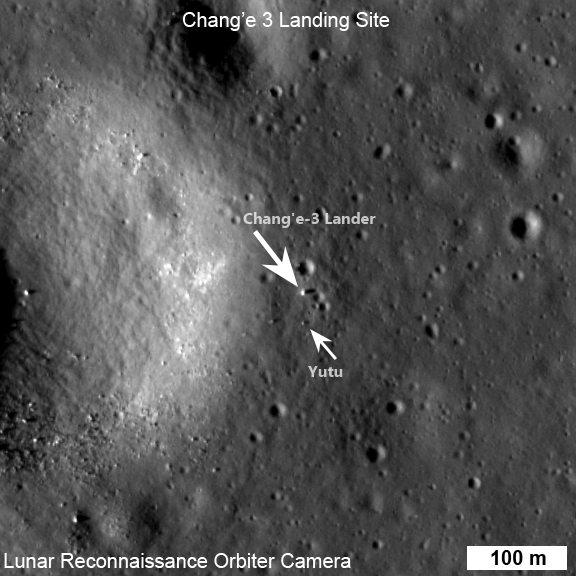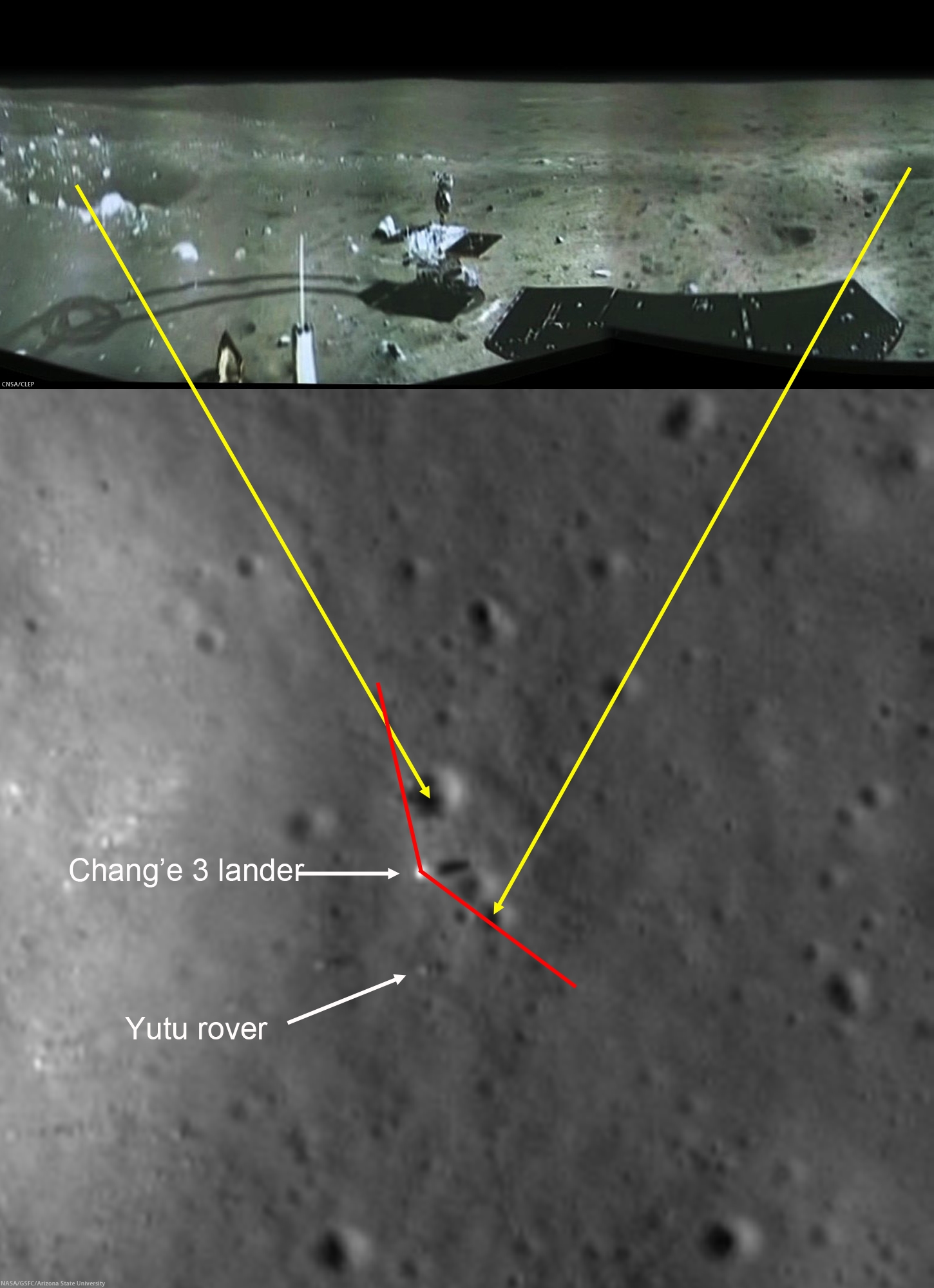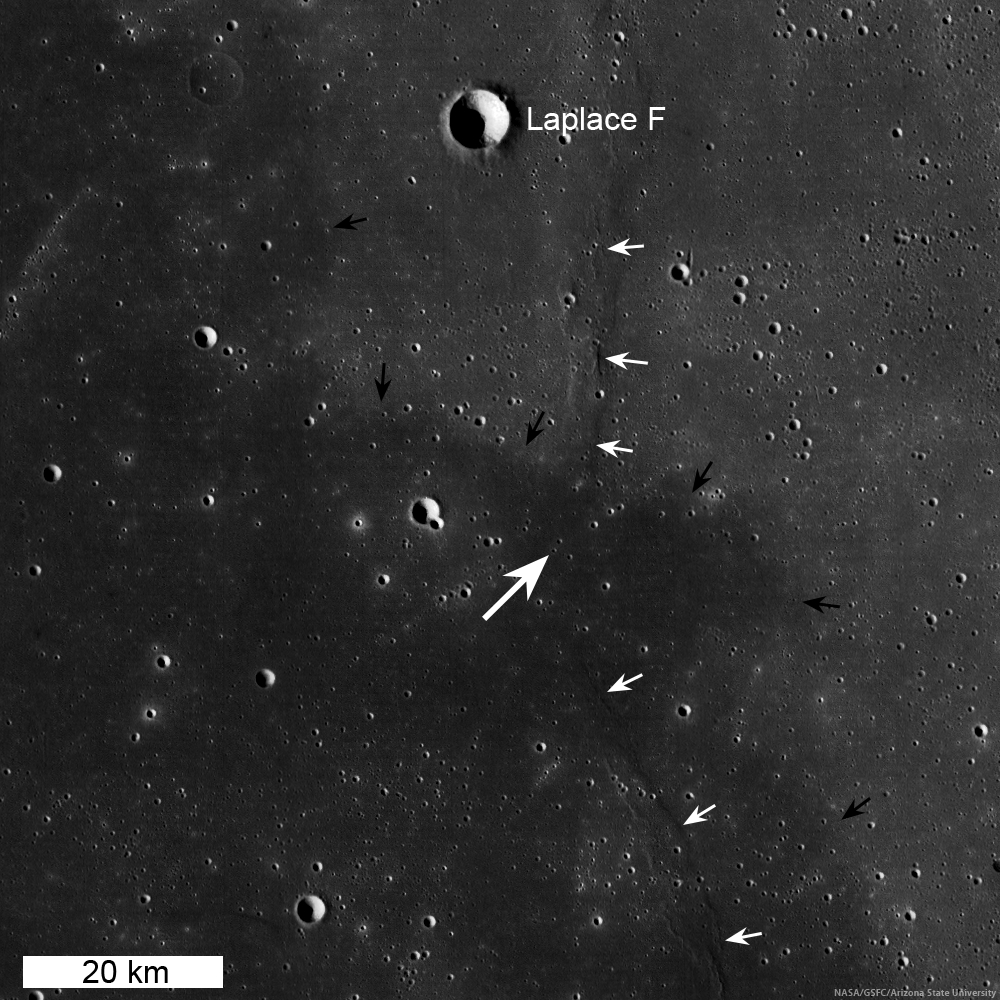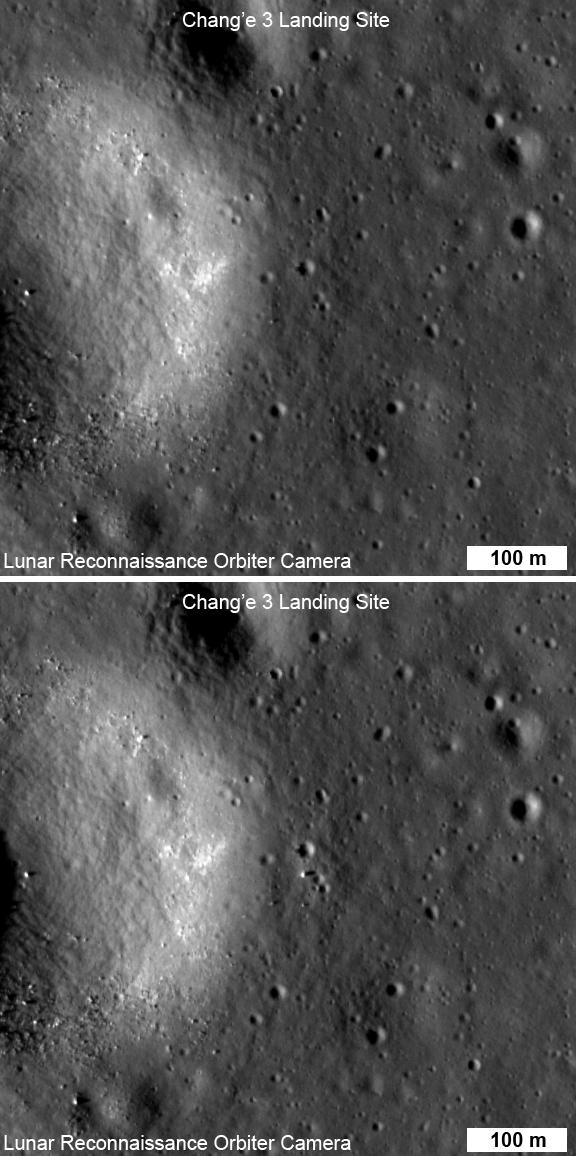 |
| LROC Narrow Angle Camera (NAC) view of the Chang'e 3 lander and Yutu (Jade Rabbit) rover just before local sunset on their first lunar day of exploring Mare Imbrium. LROC NAC M1142582775R, image field of view 576 meters [NASA/GSFC/Arizona State University]. |
Mark Robinson
Principal Investigator
Lunar Reconnaissance Orbiter Camera
Arizona State University
Chang'e 3 landed on Mare Imbrium (Sea of Rains) just east of a 450 m diameter impact crater on 14 December 2013. Soon after landing, a small rover named Yutu (Jade Rabbit) was deployed and took its first tentative drive onto the airless regolith. At the time of the landing LRO's orbit was far from the landing site so images of the landing were not possible. Ten days later on 24 December, LRO approached the landing site, and LROC was able to acquire a series of six LROC Narrow Angle Camera (NAC) image pairs during the next 36 hours (19 orbits).
The highest resolution image was possible when LRO was nearly overhead on 25 December 03:52:49 UT. At this time LRO was at an altitude of ~150 km above the site, and the pixel size was 150 cm.
The rover is only about 150 cm wide, yet it shows up in the NAC images for two reasons: the solar panels are very effective at reflecting light so the rover shows up as two bright pixels, and the Sun is setting thus the rover casts a distinct shadow (as does the lander). Since the rover is close to the size of a pixel, how can we be sure we are seeing the rover and not a comparably sized boulder? Fortuitously, the NAC acquired a "before" image (M1127248516R) of the landing site, with nearly identical lighting, on 30 June 2013. By comparing the before and after landing site images, the LROC team confirmed the position of the lander and rover, and derived accurate map coordinates for the lander (44.1214°N, 340.4884°E, -2640 meters elevation).
The lander set down about 60 meters east of the rim of a 450 meter diameter impact crater (40 meters deep) on a thick deposit of volcanic materials. A large scale wrinkle ridge (~100 km long, 10 km wide) cuts across the area and was formed as tectonic stress caused the volcanic layers to buckle and break along faults. Wrinkle ridges are common on the Moon, Mercury and Mars.
Lunar mare basalts are divided into two main spectral (color) types: "red" and "blue" (blue is perhaps a misnomer, think "less red"). Basalts on the Moon (same on Earth) are composed mainly of two minerals, pyroxene and plagioclase, though olivine and ilmenite can sometimes occur in significant amounts. The presence of ilmenite (FeTiO3) results in lower reflectance and a "less-red" color - thus the blue basalts. The landing site is on a blue mare (higher titanium) thought to be about 3.0 billion years old. The boundary (black arrows in above WAC mosaic) with an older (3.5 billion years) red mare is only 10 km to the north.
A large area LROC WAC topography map of the Imbrium basin and surrounds is available HERE.
Related LROC Featured Images:
Safe on the Surface of the Moon!
A Great Place to Rove!
LROC Coordinates of Robotic Spacecraft - 2013 Update
Principal Investigator
Lunar Reconnaissance Orbiter Camera
Arizona State University
Chang'e 3 landed on Mare Imbrium (Sea of Rains) just east of a 450 m diameter impact crater on 14 December 2013. Soon after landing, a small rover named Yutu (Jade Rabbit) was deployed and took its first tentative drive onto the airless regolith. At the time of the landing LRO's orbit was far from the landing site so images of the landing were not possible. Ten days later on 24 December, LRO approached the landing site, and LROC was able to acquire a series of six LROC Narrow Angle Camera (NAC) image pairs during the next 36 hours (19 orbits).
 |
| Yutu in a monochrome still captured from the Chang'e-3 lander, already slumbering in preparation for the bristling cold 14 day lunar night [CNSA/CLEP]. |
 |
| LROC NAC before and after images of the Chang'e 3 landing site [NASA/GSFC/Arizona State University]. |
 |
| Chang'e 3 lander panorama [Images from CNSA; compiled by Di Lorenzo and Kremer] showing Yutu shortly after it drove down the ramp to the surface. Yellow lines connect craters seen in the panorama and the LROC image (taken at a later date after the rover had moved), red lines indicate approximate field of view of the panorama. |
 |
| Another LROC Wide Angle Camera mosaic, captured at high incidence, show the extent of the wrinkle ridge in northwest Mare Imbrium. Area swept up during three sequential orbital passes in 2011. See the full-size mosaic HERE [NASA/GSFC/Arizona State University]/ |
Related LROC Featured Images:
Safe on the Surface of the Moon!
A Great Place to Rove!
LROC Coordinates of Robotic Spacecraft - 2013 Update





1 comment:
Thank you so much for the post you do. I like your post and all you share with us is up to date and quite informative, i would like to bookmark the page so i can come here again to read you, as you have done a wonderful job.
Eminem is an American songwriter, rapper, record producer and an actor. Hе hаѕ also bееn dеѕсrіbеd аѕ оnе оf thе grеаtеѕt hір-hор аrtіѕtѕ оf аll tіmе, оnе оf thе grеаtеѕt rарреrѕ оf аll tіmе аnd was lіѕtеd іn Rоllіng Ѕtоnе lіѕt оf 100 grеаtеѕt аrtіѕtѕ оf аll tіmе аt number 83. Here are a few more interesting facts and Eminem net worth you might not have known.
Post a Comment